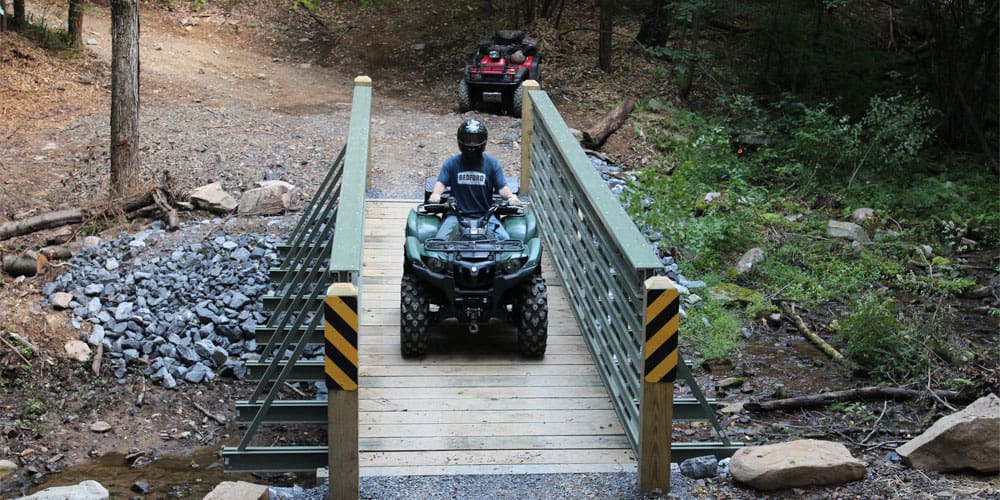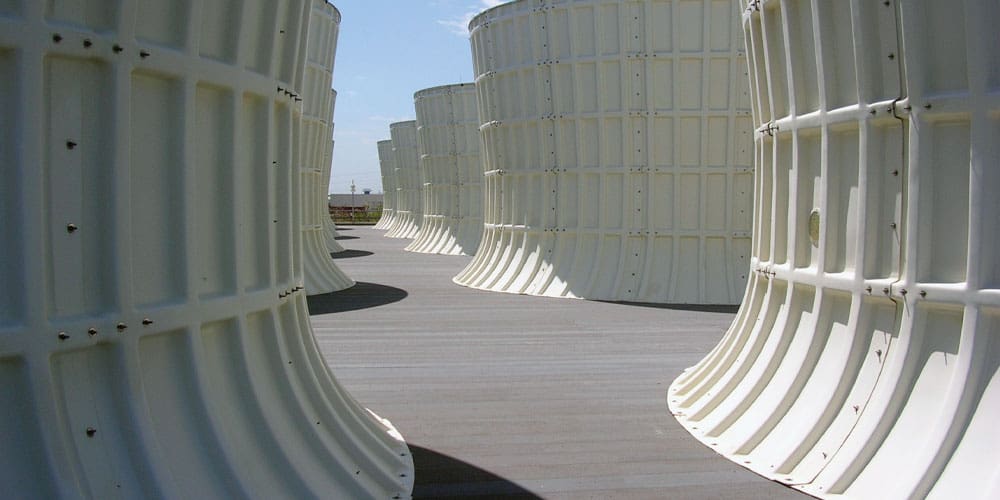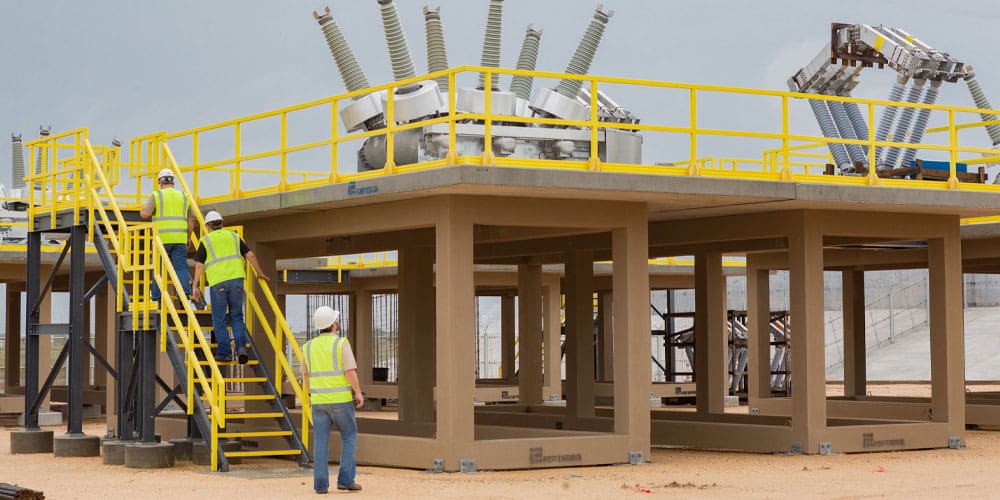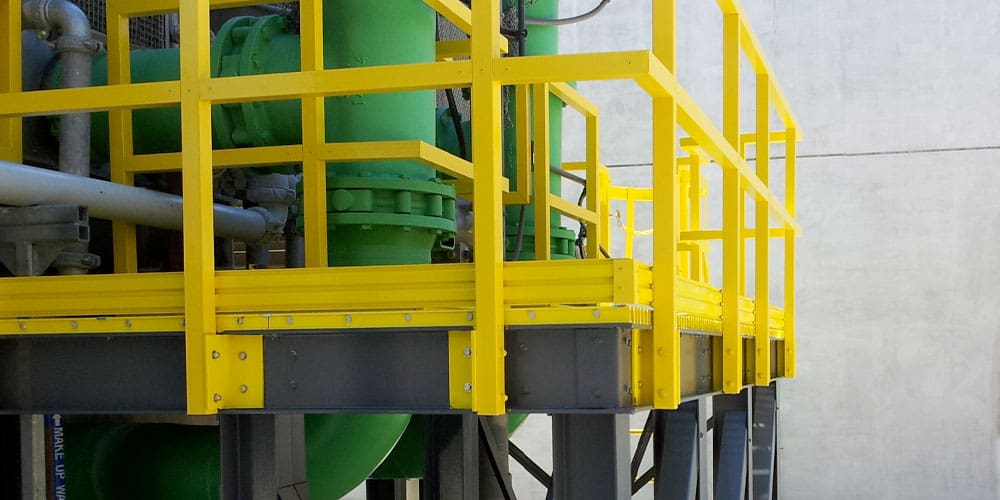Bedford fiber-reinforced plastics (FRP) are often the first materials that come to mind for industrial safety structures, cooling towers and mezzanines. But as more architects, operations managers and construction industry personnel learn about the many benefits of FRP compared to steel, aluminum and wood, uses continue to grow. In fact, we’ve identified 13 varied markets for a wide range of FRP applications.
Why? Pound for pound, FRP composites deliver the strength of steel at a fraction of the weight. Along with lowering freight costs, the high strength-to-weight ratio also reduces structural support needs and makes FRP composite materials easier to handle on the worksite. FRP composites also offer corrosion resistance, impact resistance and resistance to chemical spills and sprays, so Bedford materials hold up in humid and harsh applications that steel can’t handle. FRP offers the shear strength needed for columns and to reinforce concrete beams, and the polymer matrix increases chemical resistance and impact damage.
Check out this FRP applications video to learn more, and read on for a look at the many markets using fiber-reinforced polymer composites.
FRP applications include:
Wastewater & Water Treatment
Because FRP won’t rot, rust or corrode, it has unmatched longevity in wastewater and water treatment applications. While steel begins to rust almost immediately, even saltwater has no effect on FRP. The variety of shapes and sizes makes it easy to get the structural shapes, walkways, ladders, trough components, parallel plates, gate guides and more needed for water applications, plus all Bedford products are available with NSF potable water certification. The advantages of FRP for water and marine use go on and on.
FRP Pedestrian Bridges
Wood rots and attracts insects. Steel corrodes and needs constant maintenance. But FRP simply stands up to all of the elements without any need for maintenance or repainting. No wonder FRP composites have become the choice for pedestrian bridges, park bridges that can handle bike and horse traffic, golf course bridges and more. Bedford ReadySpan bridges are engineered to handle severe weather challenges, and they fit perfectly into a variety of projects from scenic recreation areas to cityscapes.

Cooling Towers
Fiber reinforced plastics are the ideal choice for cooling towers because FRP maintains its structural integrity throughout temperature changes and constant exposure to moisture. The high strength-to-weight ratio makes FRP a cost-effective material for tower construction materials, and ongoing maintenance costs are significantly reduced compared to steel. As this cooling tower application shows, you can use FRP with confidence in even the harshest desert climates.

Military
All FRP applications require dependability, and that’s especially true in critical military applications. Because the Army Corps of Engineers must design walkways, troop seats and more that can handle a variety of climates, they often specify Bedford fiberglass shapes. In addition to the high strength and corrosion resistance, the lighter weight of structural FRP allows for more load capacity for troops and supplies as a well as easier transport to remote locations.
Oil & Gas
Because fiber-reinforced polymer composites resist corrosion and can stand up to saltwater, FRP is the ideal material for coastal and offshore oil & gas operations. FRP stairs, platforms, catwalks, caged ladders and more can include anti-slip surfaces that help workers maintain traction despite misty and wet conditions. Whether you need a subsea drop protection solution or have an application with both saltwater and chemicals, FRP provides structural strength and long-term performance.
Utilities
While steel and aluminum conduct electricity, increasing the risk of shock, FRP is ideal for utilities because it’s nonconductive. It’s corrosion- and chemical-resistant, so it holds up against chemical tanks and exposure to the elements common to natural gas and hydroelectric power plants as well as electrical substations. Plus, unlike steel, the extreme durability of composite materials greatly reduces costly repairs and replacement of utility structures in hard-to-reach locations.

Plant & Chemical Processing
Fiber reinforced plastic platforms, ladders, guardrails and more work well in corrosive chemical plant environments. FRP won’t rust or absorb moisture, non-slip surfaces are available, and the color is integrated throughout so no painting is needed. Understanding what will work best in a specific type of environment is essential for making your material selection to help improve workplace safety. Bedford FRP solutions meet OSHA requirements and require minimal maintenance.

Pulp & Paper
The same corrosion resistance and electrically insulative properties that make FRP ideal for many industrial applications also make it just right for pulp and paper processing facilities. FRP catwalks, ladders and other structural members hold up against moisture, chemicals, heavy use and more, providing a long-lasting, maintenance-free solution in the harshest environments.
Mining
Long-term structural durability is essential in mining applications. Along with holding up against moisture, dust and chemicals that can cause steel to fail, FRP composites won’t spark or conduct electricity — a very important feature when a pocket of gas can be suddenly exposed in a mine. Because FRP offers strength at significantly less weight, it’s also much easier than steel to transport to remote locations or into tight spaces.
Agricultural
Exposure to the elements, fertilizer, pesticides and more can wreak havoc on steel, aluminum and wood. Because Bedford FRP won’t rot, warp, corrode or be affected by chemicals, it’s the ideal construction material for agricultural buildings such as fertilizer and machinery storage sheds. FRP platforms, ladders, stairs and guardrails are also a great choice for long-lasting performance in grain elevators and barns.
Architectural
Durability meets style when fiber-reinforced polymer composites are used in architectural applications. While steel adds weight that, in turn, requires more structural support, FRP is lighter for more design flexibility. Along with stairs, walkways and decking, design options include HVAC screens and aesthetic shapes. From water applications like the Hoover Dam to adding style to a parking garage, more architects are turning to FRP. Bedford can also supply engineering services.
Theme & Water Parks
Because fiber-reinforced plastic won’t rot, rust or corrode, it can stand up to the water harsh weather, constant foot traffic, water rides, chemicals and heavy equipment found in theme and water parks. FRP structural shapes, platforms, guardrails, grating and more deliver the needed strength while serving the complex design configuration needs of park structures. FRP is also a great choice for aquariums, hotel fountain displays, museums and other venues.

Golf Courses
Made from FRP, Bedford pre-engineered ReadySpan Golf Course Bridges won’t rust, rot or be affected by weather conditions. They deliver the strength needed to take the daily stress of constant traffic, require little to no maintenance and blend in seamlessly with the course design for decades of use. FRP structural shapes are also a great choice for course walkways, bleachers, maintenance sheds and more.
The number of FRP applications and markets is constantly growing. If you know of an unusual application or would like to talk with our experienced team about a custom solution for your unique FRP application, please reach out. You can request a quote or call 814-623-8125 to discuss your project.